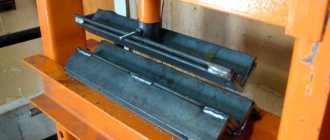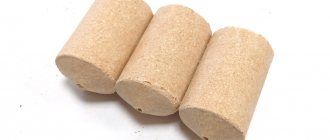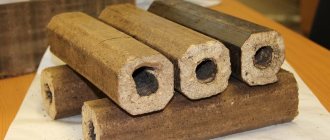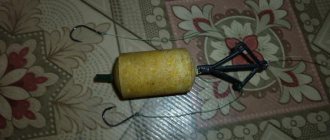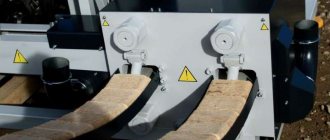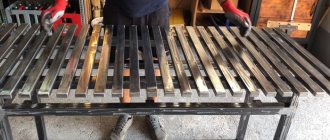The mold for technoplankton is a special design, thanks to which it is possible to produce special attachments and baits intended for catching fish such as silver carp.
The shape of such bait is a small cylinder, which includes various kinds of additives, baits, and taste enhancers. In the center there is a special hole through which the technoplankton is placed on the hook.
The operating principle of this bait is as follows:
- When the bait enters a reservoir , it begins to gradually swell and scatter throughout the thickness of the reservoir, leaving behind a small path of substances that are the basis of the diet for silver carp;
- The fish approaches the bait , attracted by pleasant aromas, after a while it swallows the bait and gets hooked;
- Depending on the manufacturing recipe, technoplankton completely dissolves in water from several tens of minutes to several hours.
In principle, it is absolutely not necessary to make such bait yourself, since it is sold ready-made in fishing stores. The only negative in this case is the too high price, which does not justify itself at all.
At the same time, there are no difficulties at all in producing a press yourself; it can be assembled from improvised means, which will cost very little.
Where to buy a mold for technoplankton?
To save their time, enterprises involved in the production of fishing products have also launched serial production of this equipment.
Unfortunately, not all companies manufacture such structures. It is much easier to purchase such a product via the Internet from some fishing master who makes them for sale.
Almost all experienced fishermen prefer to use bait and groundbait made independently, since its composition is always precisely known. Home-made technoplankton is no different in terms of catchability than store-bought ones, and fish bite on it much better.
Do-it-yourself mold for technoplankton
In order to obtain such a design at home, you need to take the following materials:
- The so-called pressing cup, which is a hollow metal tube, internal
the diameter of which should not be too large, and the walls should be thick enough. Its maximum length is 10 cm. At one of its ends there should be a thread onto which the plug will need to be screwed; - The plug is made from a standard plumbing plug , which is used in the process of making water pipes in apartment buildings;
- The pin is designed to make a hole : a hole is drilled for it in the central part, through which it will be mounted. There should be a blockage on the main tube;
- The seal is made of a steel tube , its diameter is selected so that it easily fits inside the first tube. In length it should completely coincide with the base. A piston and plug are screwed into its upper part.
There are several methods for producing technoplankton in a microwave oven:
- made of metal in the microwave , as this will damage it. It is best to use plastic tubes with a similar internal diameter;
- Take two plugs so that they fit snugly at each end. One of them is installed on the bottom side, thanks to which the bait will be pressed. When the tube is completely filled with the appropriate composition, it is closed with another stopper and baked in the microwave for several minutes;
- You can use an ordinary medical syringe , the capacity of which should be about 20 ml. The upper part is carefully cut off, filled with a nutrient mixture, plugged with a piston from another syringe, and then placed in the microwave for a few minutes.
What will you need?
To obtain high-quality technoplankton, two basic conditions must be met:
- It should create a certain turbidity in the water column - bait particles should float closer to the surface so that the water becomes less transparent;
- As a result of its use, dust must necessarily form when heavy particles settle to the bottom and pull a certain amount of turbidity from there.
It is not advisable to take too many components, as the silver carp may sense something is wrong and ignore the bait.
The following substances can be used as ingredients:
- Filler (this element is flour obtained by grinding millet or corn, crackers ground into powder and a number of other products that can be ground to such a state);
- Glue base (it should dissolve slowly in water - powdered sugar, dry cream, etc.);
- Flavorings (they can be added both in dry and liquid form - strawberry, vanilla, caramel or honey);
- Water (needed if the mixture is too dry and cannot be pressed properly. Half a gram of water will be enough for one cubic centimeter).
One of the most catchy recipes is the following:
- Half a kilo of roasted peanuts;
- Half a kilo each of semolina and corn flour;
- A kilogram of fishmeal;
- Sugar syrup made in a one to one ratio.
All ingredients must be thoroughly mixed until a homogeneous mass is obtained and sent for pressing.
Drawings and diagrams
Before you start manufacturing a mold, you need to develop its drawing or circuit diagram . This can be done by hand or in a special computer program. If you do not want to carry out such work, then you can find the corresponding pictures on the Internet, which are presented there in quite large quantities.
Moreover, there are corresponding video tutorials dedicated to making a mold for technoplankton with your own hands.
Bait production procedure
During the manufacturing process, one should not forget about a number of features of this type of bait, otherwise its effectiveness will be low or absent altogether:
- Technoplankton must contain substances that create dust when it gets into the water. At the same time, they need to easily peel off the bait and gradually float up, forming a small dust cloud;
- They take strong-smelling ingredients so that the fish finds the bait as quickly as possible by its delicious smell;
- If you follow the advice of experienced fishermen , then it is best to use oatmeal as the basis for technoplankton, which does not dissolve in water too quickly;
- It is not at all necessary to add flavorings to the bait , but with them the fishing efficiency will be even higher.
Read also: Do-it-yourself machine for sharpening drills video
Be sure to test the resulting mixture at home: place the product in a jar of water and observe how it behaves. If it dissolves too quickly, then a certain amount of starch is added to the mixture, which will reduce this indicator, making it quite acceptable.
Equipment for the production of technoplankton. (Views: 1)
STALKER6655
Re: LOB PHISHING – Catching Silver Carp
Made in Ulyanovsk. Rather, this is a work of art:
40mm with a 43mm cone with a length of 110mm - it cost me $33, before the price increased - there was a lot of demand.
Attachments
andreu555
Club Member
Orestes
Re: Technoplankton and other baits for catching silver carp
I made this 20-ton press. 15 presses without problems. The jack in the photo is redundant.
Attachments
Dilsh
Re: Technoplankton and other baits for catching silver carp
Assembled a bed for pressing technoplankton:
Bed dimensions: 685×320×180 mm (H×W×D)
Materials used: 1. Channel, 18U 2. Threaded studs, M30, strength class 8.8, galvanized 3. Steel plates, St20, 20 mm thick 4. Nuts, M30, strength class 8, galvanized 5. Washers, M30, galvanized
The design of the frame is designed for a maximum load of 25 tons with a safety factor for tensile studs k=2.7, for breaking threads of studs k=4.55, shearing of nuts k=6.18.
The jack used is from Matrix, 25 tons.
The design turned out to be strong, stable, although quite heavy.
For those interested, I am ready to send you a link to an online calculator for calculating the strength of threaded rods in a personal message.
Attachments
gegav
Re: Technoplankton and other baits for catching silver carp
Assembled a bed for pressing technoplankton:
Bed dimensions: 685×320×180 mm (H×W×D)
Materials used: 1. Channel, 18U 2. Threaded studs, M30, strength class 8.8, galvanized 3. Steel plates, St20, 20 mm thick 4. Nuts, M30, strength class 8, galvanized 5. Washers, M30, galvanized
The design of the frame is designed for a maximum load of 25 tons with a safety factor for tensile studs k=2.7, for breaking threads of studs k=4.55, shearing of nuts k=6.18.
The jack used is from Matrix, 25 tons.
The design turned out to be strong, stable, although quite heavy.
For those interested, I am ready to send you a link to an online calculator for calculating the strength of threaded rods in a personal message.
Dilsh
Re: Technoplankton and other baits for catching silver carp
I want to share one of four, truly “working” recipes, as well as the technology for making your own technoplankton at home. The efficiency of the “work” of technoplankton was achieved experimentally and practically as a result of painstaking work over a period of 3 months. Technoplankton was tested in commercial reservoirs located near the city of Almaty.
So, in order. Technoplankton parameters:
Shape – conical; Height – 50 mm; Diameter D1 – 32 mm; Diameter D2 – 34 mm; Weight – 50 g; Dissolution time in lake water at a temperature of +24 degrees Celsius –
90 min; Natural dried dill is used as a flavoring additive.
Equipment and tools used:
1. Pressing bed. 2. Bottle type jack with a lifting capacity of 25 tons. 3. Mold. 3. Kitchen scales. 4. Teaspoon. 5. Funnel. 6. Dishes for the mixture. Additional information: The pressing method is dry, without moistening the mixture.
Technoplankton dusting in water is abundant and uniform, from the first second to the last. Pressing is carried out using a bottle-type jack with a lifting capacity of 25 tons. The cost of purchased components included in the 1st barrel of technoplankton (in prices as of May 2017) is 6 rubles .
It takes 3 hours to make 40 barrels.
The entire manufacturing process consists of the following stages:
1. Procurement of components 2. Composition of the mixture 3. Mixing of the mixture 4. Sifting of the mixture 5. Pressing Now in more detail. 1. Procurement of components To produce technoplankton, I prepare the following components:
1. Pea flour.
2. Corn flour. 3. Rice flour. 4. Buckwheat flour. 5. Oatmeal flour. 6. Breadcrumbs. 7. Powdered milk (fat content 1.5%). 8. Dried (ground) dill. 2. Making the mixture I make the mixture in the following proportions:
1. Pea flour - 10 parts.
2. Corn flour – 10 parts. 3. Rice flour – 11 parts. 4. Buckwheat flour – 11 parts. 5. Oat flour – 8 parts. 6. Breadcrumbs – 5 parts. 7. Powdered milk (fat content 1.5%) – 5 parts. 8. Dried (ground) dill – 6 parts. Before adding dill and crackers to the mixture, I first grind them to flour using a blender with sharp knives and high speed. 3. Mixing the mixture
I mix the resulting mixture very carefully and for a long time in a planetary mixer, which, like no other, copes with this task with 5+.
Mixing time in the mixer at medium speed is 5 minutes. 4. Sifting the mixture
I sift the stirred mixture through the finest sieve.
The sieve that housewives use in the kitchen to sift flour is perfect for these purposes. 5. Pressing 5.1
Before pressing, I prepare a portion of the mixture weighing 50 g, weighing it on a kitchen scale (the scales in the photo indicate the weight of the mixture minus the weight of the dishes).
5.2
Using a homemade funnel, I pour a portion of the mixture into the mold.
5.3
I insert the piston into the cylinder and install the mold on the jack.
5.4
Using the handle of the jack, I raise its rod until the handle stops choking from the force of my hand.
During the very first pressing, I measure the distance from the lower end of the piston head to the upper end of the mold cylinder as shown in the photo. In my case this distance is 50 mm. I do this for the purpose of recessing the piston into the cylinder at the same distance during subsequent pressings, in order to obtain all the barrels of technoplankton of the same height. 5.5
I unscrew the jack release valve, lower the mold and take it out.
I take the lower platform with the spoke out of the mold. 5.6
Since the internal cavity of the mold cylinder is made to resemble a cone, I knock out a barrel of technoplankton from the cylinder with a light blow of my fist on the piston.
5.7
I put the technoplankton in a tightly closed container. Each barrel of technoplankton weighs 50 grams.
How to use the mold?
At the first stage, prepare the appropriate mixture, mix it thoroughly so that it is as homogeneous as possible.
Then it is poured into the working cylinder, on one side of which a plug should be screwed. When the entire volume is completely filled, the mold is closed with another plug on which the piston is installed and carefully tightened.
If you do this jerkily or apply too much force, this can lead to the product failing : it may burst, in some cases the thread will break.
When the technoplankton is made, a hole is drilled in the central part through which the bait will be put on the hook. Its maximum diameter should be about half a millimeter.
Bait production procedure
First of all, you need to choose the right bait composition for technoplankton. You can use semolina or corn flour as a base. To form a dense structure, honey or granulated sugar is added.
The prepared mixture must be placed in the working cylinder with the base installed. After backfilling and preliminary compaction, cover with the top lid. The jack is installed with the piston facing up. There must be a supporting steel plate. To form a dense structure, a force of 4-5 tons is sufficient. If this indicator is exceeded, mechanical damage to the mold may occur.
Thanks to the smooth edges, removing the finished bait is easy. The main thing is that the rod does not damage the resulting cylinder.
The video shows an example of making technoplankton at home:
How long has it been since you had a really BIG CATCH?
When was the last time you caught dozens of HUGE pike/carp/bream?
We always want to get results from fishing - to catch not three perch, but ten kilogram pikes - what a catch! Each of us dreams of this, but not everyone can do it.
A good catch can be achieved (and we know this) thanks to good bait.
It can be prepared at home or bought in fishing stores. But stores are expensive, and to prepare bait at home, you need to spend a lot of time, and, to be fair, homemade bait does not always work well.
You know that disappointment when you buy bait or prepare it at home and only catch three or four bass?
So maybe it’s time to use a truly working product, the effectiveness of which has been proven both scientifically and in practice on the rivers and ponds of Russia?
Of course, it is better to try once than to hear a thousand times. Moreover, now is the season! A 50% discount on your order is a great bonus!
Fishing means something different for every lover of this type of recreation, but a fish on a hook in any case is a welcome end to it. In order for the bite to be successful, it is necessary to master a considerable number of subtleties. In particular, study the tastes of fish. For example, silver carp, as well as carp, small carp, carp, bream, roach, crucian carp or catfish can be caught using technoplankton. This is a briquette-barrel of a mixture of nutrients that gradually dissolves in water.
The effectiveness of fishing for technoplankton depends on:
- quality and composition of technoplankton;
- the concentration of nutrients in the cloud of food it produces;
- whether the hooks are located directly in the cloud.
Making at home
Despite the fact that today there is a huge selection of all kinds of baits, including for silver carp, many people prefer to make them themselves.
Here are just some of the benefits:
- Saving money.
- Ability to create unique recipes.
- Judging by the observations of fishermen, silver carp are more willing to bite on homemade bait.
Required components:
- Adhesive and solvent components: maltodextrin, milk powder, starch, powdered sugar.
- Fillings: flour, ground crackers, ground biscuits.
- Flavors: vanilla, caramel, honey.
Both at the factory and at home, the production of technoplankton requires the following steps:
- Preparation of components for the mixture.
- Transformation of these components into a dough-like mass.
- Pressing.
Operating principle - how technoplankton works
The operating principle of technoplankton is simple. Several hooks suspended in parallel are attached to the hole for the equipment in the briquette. When the inhabitants of a reservoir swim to a cloud of food formed by technoplankton and begin to eat it, they do not see the hooks and swallow them.
The versatility of technoplankton lies in the fact that it is used both for catching fish at the bottom and on the surface with a float:
- For fishing on the bottom, it is better to use instant plankton, which dissolves in about half an hour.
- for float tackle or when there is no bite, it is better to use “long-lasting” types that dissolve for several hours.
They fish with this type of equipment from mid-spring to mid-autumn.
Principle of operation
The principle of operation of bioplankton is quite simple. 2-3 hooks are attached to the tackle hole in the barrel and hung in parallel. When the silver carp swims up to the formed cloud of hydroplankton and begins to eat it, the fish does not notice the hooks and swallows them.
In this case, the result of fishing for phytoplankton will depend on the following factors:
- whether the hooks are located in the cloud itself;
- the amount of nutrients in the formed bait cloud;
- composition and quality of technoplankton itself.
The versatility of this bait lies in the fact that it is used both for catching silver carp on the bottom and used with a float. The main differences between the methods of fishing for technoplankton are as follows:
for float equipment, or if the fish does not bite, it is advisable to use “long-lasting” varieties that dissolve in water for 2-3 hours;- For bottom fishing, it is advisable to use fast-soluble technoplankton, which dissolves in approximately 20-30 minutes.
They fish with this type of gear from early spring to late autumn.
Composition of technoplankton
Technoplankton, which is logical, is made as attractive as possible for fish. The feed ingredients are selected in such a way that they have different specific gravity and buoyancy, respectively, due to which a different level cloud of nutrients appears in the water.
The composition of the finished technoplankton remains with the manufacturer. As for self-made, it is good to use the following ingredients in its composition:
- Fillers. Everything ground to flour - oatmeal, corn or popcorn, millet, buckwheat, peas (boiled or raw), breadcrumbs, dry cookies.
- Adhesive components (glue and do not allow to dissolve quickly). Dextrin, maltodextrin, technorapid, milk powder, cream powder, powdered sugar. It is better to use a mixture of maltodextrin and powdered sugar (there is literally a little less powder), rather than them separately.
- Flavors. Can be used in any form. It is necessary to add such an amount at which the kneading will be obvious and stable. Most of all, fish loves sweet aromas: honey, strawberry, caramel, vanilla, raspberry.
- Dissolution retardant. Typically starch or rice flour is used.
- Humidifier. Usually water is added.
- A bubbling ingredient helps create a geyser effect, which promotes the dissolution of components when placed in water (any effervescent tablets, baking soda + citric acid, dry kvass starter), ratio 1/6 to the total mass.
Composition of homemade technoplankton
For silver carp fishing with technoplankton to be successful, the bait must create a cloudy cloud and be very dusty.
The process should occur slowly and gradually, if the technoplankton falls apart already 20 minutes after the tackle was thrown into the water, large pieces fall off from it every now and then, then this is a bad bait that is unlikely to work.
Proper technoplankton must contain certain groups of components.
Let's look at each of them in detail.
Fillers or base
Any cereal ground into flour can be used as a basis for making technoplankton.
Typically, fishermen mix a mixture based on semolina, corn or oatmeal, often diluting the composition with buckwheat or pea “dust”.
In general, the proportions and composition can be any, so the fisherman has ample opportunity for experimentation and creativity.
The only thing I would like to recommend is to always add oatmeal to the mixture. This ingredient gives uniform, slow dissolution and “dusts” well. A dust cloud allows the fish to quickly detect the tackle.
Binding components or "glue"
They are needed so that the compressed technoplankton does not fall apart like usual bait, but gradually melts in the water.
Another function of binding components is to create a cloudy cloud near the bait, which, like dust, attracts the attention of fish.
The best binders are starch, maltodextrin, powdered sugar, milk powder and cream powder.
You can add several ingredients at once. Powdered milk and powdered sugar work best together. The milk creates a decent cloud of turbidity, and the sugar glues the base well and gives the technoplankton a sweet taste, which the silver carp really likes.
Important! The percentage of binder to base is approximately 1:8.
Recipes for making your own technoplakton
Each fisherman makes the composition in his own way, but there are several of the most popular mixtures, which we will focus on.
Recipe 1:
- 200 grams of corn flour (you can make it from popcorn ground in a coffee grinder);
- 200 grams of wheat flour;
- 300 grams of oatmeal flour;
- 200 grams of semolina flour;
- 150 grams of soda + lemon juice.
All ingredients must be mixed and sprinkled with water. When the dough becomes plastic, it must be placed in a press and made into briquettes, or it can be baked in a microwave oven. The effervescent mixture must be mixed with the mass immediately before pressing.
Recipe 2:
- 0.5 kg of raw semolina;
- 0.5 kg corn flour;
- 300 grams of breadcrumbs;
- 300 grams of mamalyga;
- 300 grams of sugar.
Mix everything until smooth and dilute with honey solution, gradually.
Recipe 3:
- 1 can of condensed milk;
- Powdered milk mixture;
- Powder cake.
Pour a can of condensed milk into a bowl and gradually stir in the dry ingredients until the mixture reaches the consistency of sour cream. Milk and cake should be added in equal quantities. Place this in the freezer for half an hour. Then we take it out and knead it into a tight dough, again adding dry ingredients in equal quantities. Add the bulk part a little at a time; if you add a lot at once, the dough may thicken too quickly. Moisten slightly with water to make it sticky. At the end we pass it through a sieve and press it.
Recipe 4 for feeding on the bottom:
- 0.5 kg of dog food;
- 100 grams of roasted ground peanuts;
- 50 grams of dry sweet pepper;
- 1 cup powdered sugar.
If you want to use this recipe for float fishing, add more dry ingredients.
Recipe 5:
- 250 grams of ready-made fruit jelly;
- 1 tsp. honey;
- Any combination of crushed cereal flakes, breadcrumbs and powdered milk.
Read also: Screwdriver torque regulator
Mix the cooled jelly with honey, and then gradually add the dry mixture into it until a moist (but not wet) mixture is formed. Place the compressed barrels on a napkin to dry completely.
Recipe 6:
- 350 g ground flour;
- 350 g raw sunflower seeds;
- 150 grams of wheat flour;
- 150 grams of rice flour;
- 1 cup corn flakes;
- 100 grams of milk powder.
First grind all components to a powder using a coffee grinder, and then mix.
Recipe 7:
- 250 grams of sunflower seeds;
- 150 grams of shortbread cookies with creamy taste;
- 125 grams of dry cream;
- 250 grams of cooked peas;
- 250 grams of fish bait;
- 250 grams of semolina;
- 125 grams of protein powder;
- Flavoring.
Grind all ingredients and mix.
Recipe 8:
- 0.5 kg corn flour;
- 250 g rice flour;
- 250 g pea flour;
- 250 g buckwheat flour;
- 250 g milk baby food with rice;
- 250 grams of raw peanuts;
- 250 g raw sunflower seeds without peel;
- Honey syrup.
Recipe 9:
- 1 tbsp. Sunflower seed;
- 150 grams of dry cookies with vanilla flavor;
- 250 grams of chopped popcorn;
- 250 grams of semolina;
- 250 grams of corn flour;
- 250 grams of milk powder;
- 125 grams of cucumber flour.
To make cucumber flour, you need to grate the cucumber, dry it and then grind it. The flour has a fairly strong aroma, which attracts silver carp well.
Recipe 10:
- 4 parts flour for hominy;
- 4 parts millet flour;
- 1 part rice flour;
- 1 part milk powder;
- Vanilla flavored sugar syrup.
Mix everything, adding syrup periodically. The total syrup should be added to about 30% of the total mass. Then let the mixture rest for 60 minutes. And at the end, we pass through a coarse sieve, press and dry.
Sugar syrup: 1 part water + 1 part sugar + vanilla, boil everything for 20 minutes and cool. If you need to increase buoyancy, add crushed cork.
How to increase your fish catch?
Over 7 years of active fishing, I have found dozens of ways to improve the bite. Here are the most effective ones:
- Bite activator . This pheromone additive attracts fish most strongly in cold and warm water. Discussion of the bite activator “Hungry Fish”.
- Increased gear sensitivity. Read the appropriate manuals for your specific type of gear.
- Pheromone -based lures .
What is needed for production?
At the moment, technoplankton is produced at home in two ways:
- Power pressing of the mixture in a special metal mold without heat treatment.
- Baking the composition lightly pressed in a plastic mold in the microwave.
The second option is much more affordable, because the material for making molds is much easier to find.
In fact, any plastic tube of the required diameter (about 3.5 cm) is suitable for making technoplankton.
You also need to make a plug and a piston that will compress the mixture inside the tube. The easiest option is to use a 20 cc syringe as a plastic mold.
Manufacturing process:
- The raw materials are poured into the mold, then a piston is inserted into it, and the mixture is compressed with a slight force.
- Then, the mold is placed in the microwave for 7-10 seconds, after which the raw materials are finally compressed using a piston, and the entire structure is sent into the microwave for 25-30 seconds.
- After this, you can remove the ready-made technoplankton outside.
Press for the production of technoplankton
To prepare technoplankton at home, you need to get a press.
There are several types of presses for its manufacture:
- Pressing with a manual screw press.
- Squeezing with a jack.
- Using a high pressure hydraulic press.
- Pressing in the microwave.
Simple cold pressing mold:
- Glass for pressing. You need a metal tube 8-10 cm long with a small diameter and a thread at the end for screwing on the plug.
- Cork. A screw-on plug for water pipes can be used as a plug.
- Pin for a hole in the tackle. You need to drill a hole in the plug cap and fix a thin but strong pin in it to make a hole in the finished barrel. Screw the plug onto the main tube.
- Seal. To compact the substance, you need to select a metal cylinder of such a diameter that it fits tightly and easily into the tube. The length of the cylinder should be the same as that of the tube. You can also screw a plug onto the inner piston cylinder from above.
Scheme of work:
- Screw the plug onto the main tube.
- Fill the tube with the mixture.
- Insert the piston.
- Clamp the structure using a bench vice, jack or clamp.
- Remove the piston and unscrew the cap from the tube.
- Push out the resulting barrel of technoplankton.
For pressing in the microwave, you can use several options:
- Using a plastic tube. From a plastic pipe of small diameter (about 30 mm, maybe smaller), you need to cut a piece of about 4-7 cm. Then you need to select 2 plugs that will tightly close both ends of the tube. Immediately close one end with a stopper and stuff the mixture tightly. Close the other end with a stopper and bake in the microwave. You can simply try to tightly fill a piece of tube without lids and put it in the oven. But with one lid, this form is much more convenient to fill out.
- Using a syringe. You need 2 disposable syringes with a volume of 20 ml. Cut the syringe from the side of the needle nose so that you get a cylinder. On the one hand, plug the syringe with a piston, fill it with the substance and, on the other hand, press it tightly with a piston from another syringe. Then you can leave the second piston, or you can remove it and put the cylinder in the microwave.
Press for technoplankton
Without a press it is impossible to achieve a high result, since the mass, while in water, must gradually turn into a dust cloud.
Depending on the pressing method, you may need:
- metal or plastic pipe;
- cylinder or plug;
- pin;
- compression device;
- ejector piston;
- microwave;
At first glance, the product may seem technologically complex, but, in fact, anyone can make such bait at home.
There are two pressing methods:
Cold pressing:
- You will need any metal tube about 90 cm long.
- You need to select the appropriate cylinder for it.
- A hole is drilled in its lower part for a pin, which will be attached to the lower plug, threaded onto the lower part of the tube.
- Pour the mixture to the very top using a watering can and compact it.
- Separate the mixture from the molds. The result was a small but dense briquette.
- The mixture placed inside the tube is pressed using a vice or clamp.
Hot pressing:
- The mixture is placed in a plastic pipe with a tight-fitting stopper.
- The mixture is compacted by an ejector piston.
- Place it in the microwave for 30 seconds and set it to maximum power.
- After extraction, the mixture is compacted again.
Cold pressing and microwave, what's the difference?
During cold pressing, the prepared mixture is placed in a device and, using pressure, gives it hardness, turning it into a tablet barrel.
When pressing in a microwave, the energy of electromagnetic radiation is used. To do this, the substance is placed in a plastic tube with stoppers at both ends and baked until the desired state is reached for about 20–30 seconds. Instead of a tube, you can take a disposable large syringe.
As a result of using these two methods, you will get almost the same result.
Adviсe
- When preparing the mixture, pay attention to what type of fishing you are doing it for.
- At different times of the year, silver carp likes different flavors of bait.
- If the pond is heavily bloomed due to the heat, then the fish, on the contrary, will not be interested in feeding due to the abundance of food in the pond. During such periods, for fishing, look for bodies of water with clean water.
- When fishing with bottom gear, be sure to “raise” the hooks above the technoplanton using foam balls; when fishing with float gear, there is no need to hook them.
- If the current carries a cloud of food away from the hooks, then you can use a small sliding weight on the fishing line (cord) between the float and the rod. Be careful, when retrieving your catch, the tackle may become tangled.
- Don't forget to frequently replace your hooks with new ones or at least sharpen them before each fishing trip.
A group of fishermen revealed the name of the secret bait during interrogation.
The press mold for technoplankton (TP) allows you to make special baits for fishing with your own hands. TP looks like a cylinder, which contains various additives, baits, and flavor enhancers. A hole for a hook is provided along the central axis.
Read also: Automatic charger shutdown circuit
What is this?
- Technoplankton is a mixture of various components that are pressed into the shape of a small cylinder;
- When technoplankton finds itself in water, the composition gradually comes into contact with it, becomes softer, and leaves a muddy trail of food;
- The fish, which smells pleasant odors, begins to move towards the technoplankton, swallows it and ends up hooked;
- The rate of decay of technoplankton can range from 15-20 minutes to several hours;
- The decomposition depends on what the composition is made of and what components are included in it.
Purchasing technoplankton for fishing in specialized stores is very expensive. The price doesn't justify itself at all. At the same time, there are absolutely no difficulties in making a special press with your own hands. We invite you to figure out how to assemble the press and get a budget tool for preparing highly effective bait.
Various recipes
We offer several technoplankton recipes for your consideration.
Recipe one:
- 0.5 kg corn flour;
- 0.3 kg mamalyga;
- 0.5 kg semolina;
- 0.3 kg breading;
- 0.3 sugar;
Mix in a bucket and compress.
Recipe two:
- 1 can of condensed milk;
- piece of powder cake 5x5 cm;
- powdered milk;
Condensed milk is poured into the container with the gradual addition of milk powder and cake. Turns into a creamy mass with a mixer. Place in the freezer for 40 minutes. After this, the mass is kneaded like dough.
Gradually add milk powder and cake again. We combine all this with water and bring it to the state of glue. The resulting glue is then passed through a fine sieve until the mixture becomes grainy, like sand.
Recipe three, part 1:
- 200 g sugar;
- 50 g paprika;
- 100 g roasted peanuts;
- 500 g dog food;
Recipe three, part 2:
- 500 g boiled potatoes;
- 1 kg bananas;
- 1 yolk;
- 50 g condensed milk;
First you need to grind the peanuts. Then mix all the ingredients of each part in separate containers. After this, combine and knead, turning into dough.
Recipe four:
- 350 g macadamia;
- 350 g sunflower seeds;
- 150 g millet;
- 150 g rice;
- 1 cup corn;
- 100 g milk powder;
- 1 glass of fruit jelly;
Grind millet, corn, rice and seeds in a coffee grinder. Mix the jelly and dry ingredients with a mixer. Bring to a wet sticky mixture, press, place on a napkin and dry.
Recipe five:
- corn flour – 9 g;
- ground dry spicy herb – 1 g;
- fried wheat bran – 5 g;
- premium corn dextrin – 7 g;
- honey – 3 g;
Everything is thoroughly mixed and compressed by a press with a pressure of over 20 tons. You need to compress the dry mass. The resulting pancake is broken into several parts and pressed again.
The result was high-quality tablets, similar to professional packaging ones. Buoyancy and dissolution rate are acceptable.
Recipe six:
- the basic composition is unchanged: flour, flour, bran - at your discretion;
- grated cucumbers;
The cucumbers are grated and then dried in an electric dryer. After drying, they are passed through a coffee grinder. The result is cucumber flour with a pleasant smell that attracts fish. Mix the dry ingredients with the cucumber, press and the bait is ready.
The nuances of making a press
Mold drawing
You don't need complex drawings to assemble the press. You can protect yourself with drawings and watch training videos, which will only benefit you when creating a high-quality form.
The main nuances of the assembly are the competent calculation of components and the choice of an effective pressing device. The most common bottle-type car jack performs well in the role of the latter.
The approximate dimensions of structural elements for technoplankton are as follows:
- A hollow cylindrical shape into which the ingredients will be loaded. Choose the walls of the metal tube with a thickness of about 5 mm, and the height of the cylinder - 60 mm. An internal diameter of 27 mm is quite enough for preparing bait;
- Support nickels. They should be made with an inner rounded surface. To ensure reliable support, provide a size 4-6 mm larger than the working cylinder. In the center, a rod is attached by welding, which is necessary to form a longitudinal hole in the TP. Usually the length is 5 cm;
- Upper element of the press. Choose a cylinder with an outer diameter of about 27 mm, depending on the inner diameter of the hollow cylinder. That is, they should be the same.
If you correctly select all the components of the structure that fit perfectly together, you will get technoplankton of excellent quality. You will be able to produce bait that is smooth, beautiful, and dense enough for successful fishing. For comparison, the price of a finished press is 1000 rubles.
How to cook technoplankton
To prepare technoplankton with your own hands, having special molds at your disposal, you need to follow a few simple recommendations and consistently carry out all operations.
- Choose the appropriate composition for preparing future bait. There are a huge number of recipes, so you will have to use an experimental method to select the composition specifically for your region or body of water. Or consult with experienced fishermen, find out what fish bite best. This is already your task.
- Semolina or corn flour is usually used as the basis for preparing TP. To make the composition more dense, add a little sugar or honey.
- The prepared composition is loaded into the working cylinder.
- After filling the mixture, tamp it down a little and cover with the top lid.
- Install your bottle car jack with the stem facing up. In this case, do not forget about the need to use a steel support plate.
- To obtain technoplankton of sufficient density, it is enough to press the cylinder with a force of up to 5 tons. If the force is higher, you may damage the assembled mold. This is another powerful argument in favor of do-it-yourself presses. Beginners often do not calculate the load, which is why the new product breaks. I have to shell out about 1,000 rubles again to make bait for the fish.
- The smooth edges of the press machine ensure free exit of the finished technoplankton from their cylinder. Sometimes it makes sense to brush the edges with flavored oil. It will definitely prevent technoplankton from getting stuck in the cylinder, plus it will give additional attractiveness to the bait in the eyes of the fish.
Secrets of a good catch
Technoplankton is mainly used to catch the following types of fish:
At the same time, it is quite possible to catch a number of other representatives of the underwater world using technoplankton. By making a cylindrical bait of a smaller size, bream, rudd, crucian carp, etc. can easily be used on it.
There are several techniques that allow a fisherman to be more confident that he will not return empty-handed from fishing.
- Use bite activators when fishing. Many do not trust modern means based on the use of various additives and ready-made mixtures for bait. In practice, their production is based on an analysis of the behavior of fish, its reaction to various components. A striking example is how fishing is activated when using chocolate-flavored bait.
- Use high-sensitivity equipment when biting fish. When the water is turbulent, or a rather tricky fish is being caught, the fisherman does not always notice the beginning of the bite due to rough equipment. By increasing the sensitivity of the float, the percentage of fish that fall off the hook will drop sharply.
- Don't use hooks that are too big. Many fishermen, in pursuit of a big catch, rely on a large hook. They believe that small hooks will not be able to hold a large trophy. In fact, this works in reverse. A small hook allows you to catch fish of various sizes. The main thing is that it swallows the bait, that you hook it correctly, and that the fishing line can support the weight of the catch.
- Pheromones are excellent at stimulating increased activity. Another example of modern developments for fishing. Most importantly, they work great. The main thing is to choose a pheromone that is suitable specifically for the fish that is found in the reservoir. Or the fish you set your sights on when you go fishing.
Nuances of preparing and using technoplankton
To ensure that the cylinders of prepared technoplankton work effectively, listen to a few tips for catching fish with this bait.
- Studying various recipes for preparing technoplankton, we can conclude that there is no universal composition. Therefore, you should experiment with the compositions;
- The buoyancy of technoplankton is one of the main points worth paying attention to;
- When fishing from the bottom, bran or finely chopped wine cork should be added to technoplankton;
- If you plan to use technoplankton for fishing below the surface, use more flour in the composition. This will allow technoplankton to leave behind a muddier trail that attracts fish;
- When fishing for silver carp in the summer and on hot days, use flavorings or natural ingredients of garlic and honey when preparing the technoplankton composition;
- In autumn and spring, fish bite better on the smells of herbaceous components. Therefore, add them to technoplankton.
Fish is not the main thing in fishing. But who doesn’t want to go fishing and come back with a whole fish tank?! To do this you will need an effective bait and a little luck.
